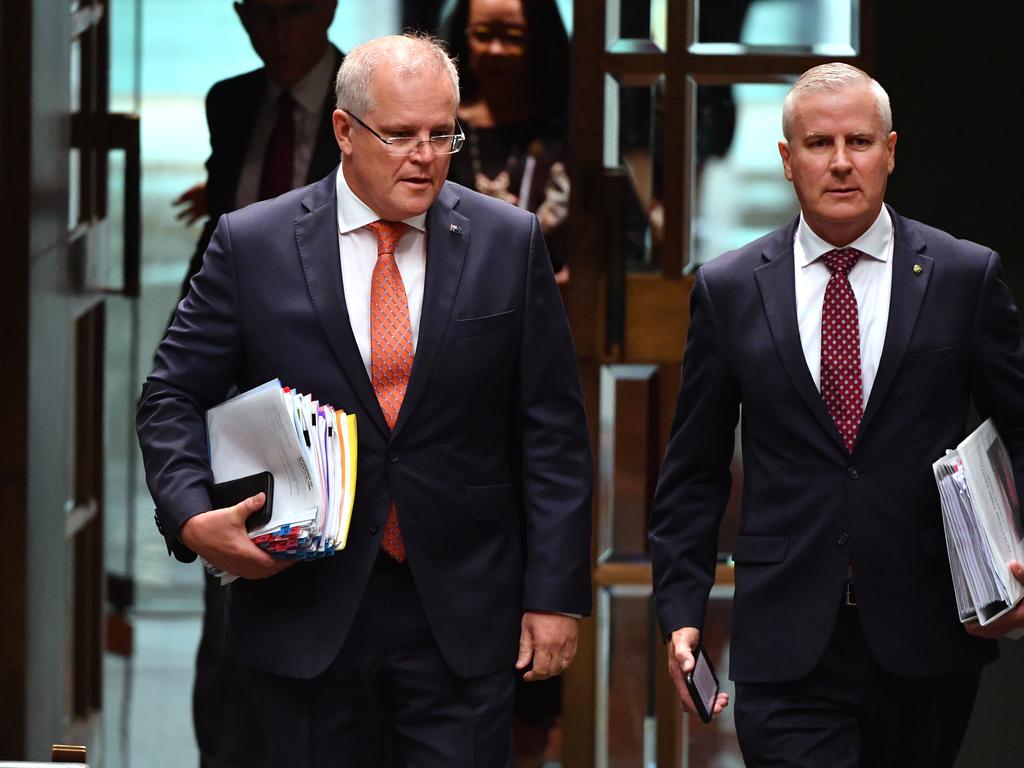Scott Morrison must find sweet spot between science and politics


Nobody knows the full ramifications of this commitment. There is no precedent for Australia and the world using a scientifically based projection of temperature consequences as a trigger for a massive reconstruction of domestic and global energy markets.
But this is the demand in a globalised age. Boris Johnson wants every country to outline its plan to achieve net zero in Glasgow this year. UN Secretary-General Antonio Guterres said the planet was “edging closer to the point of no return” and governments must deliver “transformational change” at Glasgow. If leaders dithered then “we are doomed”.
This is the language of climate emergency generating a unique coalition of support — from the EU, global finance, corporate CEOs, progressive politicians with their Green New Deals, state governments in Australia and activists demanding more urgent action.
It is nine months since the election but Scott Morrison is under pressure to abandon the climate change policy he took to it and commit to net zero by 2050, a reversal that many would see as a political betrayal and a violation of the Prime Minister’s emphasis on sticking by his mandate.
In this context, the bushfires have a global significance. Abroad their impact is exaggerated to pressure Australia as a fossil fuel power to break from its alleged unsustainable past. At home, the bushfires are recruited by the climate change lobby to argue public opinion has changed so Morrison, if he stays firm, is out of touch and, if he changes, he concedes the folly of recent Coalition policy.
The critical feature of the Australian debate recently is the escalation of pressure from major companies and CEOs for action on the 2050 target. This is mirrored in the upgraded stance of the Business Council of Australia with its chief executive, Jennifer Westacott, saying Australia must become a “clean energy superpower” and that it was time to move beyond the damaging political conflict over the past decade.
But the transition pathway is undefined and unplanned. Westcott and the BCA scoping paper make clear the task now is to devise a plan for how “the Australian economy most effectively and efficiently delivers growth while achieving net-zero emissions”. For the BCA, the advantage of the 2050 target is that it shifts the political debate away from the disputed 2030 targets and, by offering a long-term goal, provides scope for durable policies to ensure emissions are cut from every sector.
This 2050 goal is transformational for Australia and the world. If embraced, it will dominate the economic reform agenda for years. Economic logic says the goal must dictate a carbon price, but neither Liberal nor Labor will buy that. This makes the transition more problematic and unpredictable.
Announcing a target is easy; devising the policies to get there is hard. The story so far, as the UN points out, is that many nations signing up have no plan to achieve the target. Westacott said what really matters is how to get there. The BCA says: set the target first, then sort out the mechanism. Its concern is that without the target, the multinationals and investment community won’t put the funds into the new technologies the Morrison government talks about.
The politics of this are global, not just domestic. They are a function of the globalised world of flexible capital and the search by multinationals to win public respect by tying their brands to environmental idealism. The problem for the Morrison government is not Labor. The deeper problem is being boycotted by global capital and marginalised post-Glasgow.
Morrison yesterday toughened the test for whether to embrace net zero by 2050. The government is assessing what this pledge would mean for the economy. “No one can tell me that going down that path won’t cost jobs, won’t put up your electricity prices and won’t impact negatively on jobs in the economies of rural and regional Australia,” Morrison said.
These are defining comments and may be the most significant for Morrison since the election. The point is that nobody can give Morrison such a guarantee. If this is the test Morrison imposes, the result seems obvious. In an earlier generation, leaders talked of winners and losers and compensating losers. But the structural and price changes in this instance seem too immense, even given that the transition may be in the national interest. This penetrates to the enduring conundrum in climate change politics: can the short to medium-term pain be accepted by leaders and the public for the long-run dividends? The related issue for Morrison is that the Paris Agreement, so far, is failing. The reality is that 2050 targets are being imposed because the short-term targets are not being met.
The UN Emissions Gap Report for 2019 says: “There is no sign of greenhouse gas emissions peaking in the next few years. Every year of postponed peaking means that deeper and faster cuts will be required” to meet the scientifically determined goal of limiting global warming to below 2C and 1.5C.
The gap between what the science demands and what governments pledge is too large, such that today’s national pledges need to be increased threefold to meet the temperature targets. The prospect of this is remote.
At the same time, emissions restraint by rich nations is easily outpaced by emissions expansion from the developing world, China and India, with many developing nations investing in coal-fired power plants that will run for decades. Morrison has identified the problem: what does he say to Australians asked to accept higher targets that cannot on their own slow global warming when China, the world’s largest emitter, continues its course of emissions expansion?
The UN report says only “rapid and transformational” action will do the job. The certainty for Australia is that “transformational” policy is high-risk politics.
This is a huge challenge not just for Morrison but for the business community. Do CEOs appreciate the magnitude of the task they have set themselves and how different drafting a national transition strategy is from a plan for their own company?
In this project, every household and business will be affected. The people most vulnerable in the transition will be those on welfare, those on low or low to middle incomes, those in the regions and connected to the coal economy, mining and manufacturing.
As the election revealed, Australia is already a fractured country and many of these people, alienated by technological change, green ideology, feelings of powerlessness and being lectured to by elites, may enter a new threshold of resentment when faced with “transformational” step-ups on climate change. The risk is the 2050 project ends up resembling a crusade driven by elites in terms of income, education, power and influence — guaranteeing a serious backlash from many Australians.
The idea of a 2050 net-zero commitment would initially be popular, winning huge elite support. But this could be a trap. Remember the Rudd-Gillard years. How long would it last when the transition plan and costs were revealed? Would vision and the winning interest groups carry the day? Perhaps. But the politics would be dangerous for Morrison. Labor is expected to endorse the target. The Coalition with the Nationals could be imperilled as it would trigger a populist revolt on the right Morrision could not control.
The government is right to ramp up a technology agenda, but it’s no substitute for action on targets. The climate change issue constitutes a fusion of global and domestic politics. Morrison wants to lift his credibility on climate action but not at the expense of jobs and prices. But such double goals don’t compute. In this decision, Morrison faces global and domestic pressure to reinvent his prime ministership, but that may come with the stamp of electoral doom.







The coming epic clash over net-zero carbon emissions reduction targets by 2050 is not just about the economy and climate change; it is about Australian democracy in an age of globalisation and universal climate threat.